To keep your vacuum cleaner running at its best, regular maintenance is key. Start by unplugging it and removing hair or debris from the brush roll with scissors. Clean detachable parts using warm, soapy water. Don't forget to wash the dust canister or bag and guarantee everything dries properly. Check and clean filters every 1-3 months for better suction. Look out for clogs or unusual smells and address them promptly. By following these steps, you'll maintain peak performance and extend your vacuum's lifespan. For even more effective tips and tricks, you might find the following information helpful.
Importance of Vacuum Maintenance
Why is vacuum maintenance so important for your home? Regular vacuum maintenance is essential for keeping your living space clean and healthy. When you don't maintain your vacuum, dust, debris, and hair can accumulate, leading to clogs that greatly hinder performance. By routinely emptying the canister or bag, you guarantee consistent suction power, which is crucial for effectively removing dirt and allergens from your environment. Additionally, ensuring regular filter cleaning helps improve air quality and suction efficiency. A well-maintained vacuum can significantly enhance your cleaning efficiency, allowing you to tackle messes more swiftly and thoroughly. Moreover, investing in high-quality cleaning tools can further improve your vacuum's performance and longevity.
To get the best results, you should clean your vacuum at least once a month. This includes checking filters, brushes, and hoses for any buildup that could affect its efficiency. A well-maintained vacuum not only extends its lifespan but also boosts cleaning efficiency, giving you quicker and more effective results. Furthermore, regular upkeep helps reduce the buildup of dust and bacteria, promoting better indoor air quality for you and your family.
In short, prioritizing vacuum maintenance allows you to enjoy a cleaner home while making sure your vacuum works at its best.
Cleaning Supplies Needed
To keep your vacuum cleaner in top shape, you'll need a few essential tools and cleaning solutions.
Scissors or a utility knife for removing hair and debris, warm water for rinsing parts, and dish soap for stubborn grime are all must-haves. It's also helpful to incorporate time-saving strategies into your cleaning routine to ensure you maintain your vacuum efficiently. Additionally, storing your cleaning supplies in designated areas can enhance accessibility and organization, making your cleaning process smoother.
Don't forget an all-purpose cleaner and microfiber cloths to guarantee everything's disinfected and dry before putting it back together. Additionally, consider using non-toxic cleaners to ensure a safe cleaning environment while maintaining your vacuum.
Essential Cleaning Tools
Having the right cleaning tools on hand is vital for maintaining your vacuum cleaner effectively. Start with scissors or a utility knife, which are key for cutting away hair and debris tangled around the brush roll. This step will help keep your vacuum operating at peak performance.
Next, gather a supply of warm water for rinsing washed components. It's important to confirm everything is free of soap residue before reassembling. Dishwashing soap is excellent for tackling sticky or greasy debris on vacuum parts. It restores functionality and keeps your vacuum in top shape.
Don't forget about the exterior! An all-purpose cleaner is great for wiping down surfaces, maintaining both appearance and hygiene. For drying and polishing components, microfiber cloths are your best bet. They're gentle on surfaces and won't scratch.
Lastly, if you're planning on cleaning the hose, have a brush or pipe cleaner handy to remove any clogs. With these vital tools at your disposal, you'll make cleaning your vacuum a breeze and guarantee it works efficiently for years to come.
Recommended Cleaning Solutions
When it comes to maintaining your vacuum cleaner, the right cleaning solutions can make all the difference. To keep your vacuum performing at its best, you'll need a few essential supplies.
Start with an all-purpose cleaner, which works wonders for wiping down the exterior surfaces. This helps enhance your vacuum's appearance and prevents unsightly buildup from accumulating over time.
Next, you'll want soapy water to clean detachable parts effectively. Mix a few drops of dishwashing soap with warm water and use this solution to rinse and scrub any debris from components like filters and canisters. This step is vital for maintaining peak suction and performance.
Don't forget to stock up on microfiber cloths. These are perfect for drying various parts of your vacuum and guarantee that no lint or residue is left behind.
Keeping these recommended cleaning solutions handy will make regular vacuum maintenance a breeze. By incorporating these supplies into your cleaning routine, you'll extend the life of your vacuum and keep it running smoothly for years to come.
Safety Equipment for Cleaning
Maintaining your vacuum cleaner safely requires the right tools at your disposal. Start with scissors or a utility knife to cut away hair and debris snagged in the rotating brush. This is essential for effective cleaning and maintaining ideal vacuum performance.
Next, gather warm, soapy water and dishwashing soap. These are excellent for rinsing removable parts and breaking down stubborn grime, ensuring your vacuum remains in top shape.
An all-purpose cleaner is also important for wiping down external surfaces, promoting hygiene and a polished appearance.
Don't forget microfiber cloths; they're perfect for drying and wiping surfaces. Their design traps dust without scratching delicate components, adding an extra layer of safety to your maintenance routine.
Finally, always have a flexible plastic drain snake on hand. It's a handy tool for clearing clogs in hoses, as unobstructed airflow is critical for vacuum performance.
Step-by-Step Cleaning Process
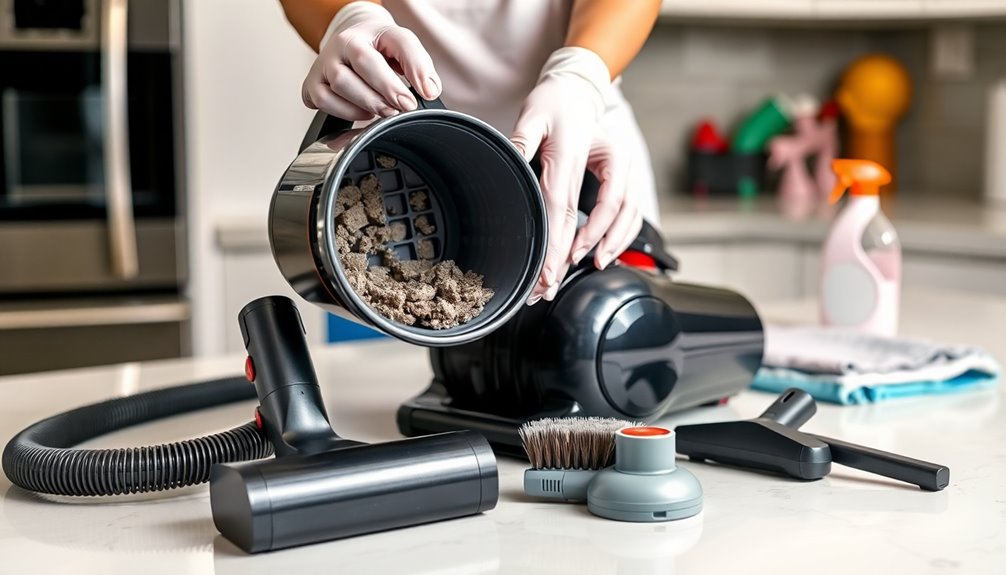
Before you start cleaning your vacuum, make sure to unplug it for safety. Regular maintenance, including cleaning the vacuum, is essential for efficient management of your cleaning responsibilities. Regular cleaning of your vacuum can significantly enhance its cleaning efficiency.
Next, grab some scissors or a utility knife to remove any hair and debris from the rotating brush.
Finally, take off any non-motorized attachments, shake off the debris, and get ready to wash them with warm, soapy water. Regular maintenance tips will help ensure your vacuum operates at peak performance and lasts longer.
Safety First: Unplug Vacuum
Unplugging your vacuum cleaner is essential for safety during the cleaning process. Always make it a habit to unplug your vacuum before you start working on it. This eliminates the risk of accidental activation and keeps you safe while you clean.
Before you even unplug, take a moment to check the power cord for any signs of damage. Frayed cords can pose serious electrical hazards, so it's critical to verify everything's in good condition.
Once you've confirmed the cord is intact, turn the vacuum off and give it some time to cool down, especially if you've been using it for a while. After unplugging, allow a few moments for any residual power to dissipate. This step is important as it reduces the chance of electric shock or injury when you handle the vacuum's components.
Keep your vacuum unplugged while you disassemble or clean any parts. This precaution helps prevent injuries and protects your vacuum from potential damage.
Remove Hair and Debris
Hair and debris can quickly clog your vacuum cleaner, reducing its suction power and efficiency. To guarantee peak performance, start by unplugging your vacuum to avoid any electrical hazards.
Next, you'll want to clean the brush roll. Use scissors or a utility knife to carefully cut away any tangled hair and debris. Make sure you remove all materials to maintain a smooth rotation.
After you've tackled the brush roll, inspect and clean any lint traps if your vacuum has them. Clogged traps can greatly hinder suction, so it's crucial to keep them clear.
Then, detach any non-motorized attachments such as hoses and nozzles. Shake them out and wipe away any accumulated debris for thorough cleaning.
As part of your regular maintenance routine, remember to check your vacuum filters as well. If they're dirty, replace or clean them according to the manufacturer's instructions.
Once you've completed these steps, you can wash any removable parts in warm, soapy water. Rinse thoroughly and allow them to dry completely before reassembling your vacuum cleaner.
Clean and Rinse Parts
To keep your vacuum cleaner functioning efficiently, cleaning and rinsing its parts is vital. Regularly performing this routine maintenance helps remove dirt and prolongs the life of your appliance.
Follow these steps to clean a vacuum thoroughly:
- Unplug Your Vacuum: Always start by unplugging the vacuum to guarantee safety during cleaning.
- Remove the Roller Brush: Take out the roller brush and use scissors or a utility knife to cut away any hair or debris entangled around it. This keeps the brush rotating freely and effectively.
- Detach Non-Motorized Attachments: Remove any attachments, shake them to remove loose debris, and then rinse them in warm, soapy water. This assures you eliminate any hidden dirt.
- Clean Removable Parts: Wash components like the dust canister or bag in warm, soapy water. Make sure to rinse them thoroughly and allow them to dry completely before reassembling to prevent mold or mildew growth.
After cleaning, inspect all parts for damage or wear.
Verifying they're completely dry before reattaching is essential for peak performance.
Disinfecting Your Vacuum
Disinfecting your vacuum is essential, especially when it's used in high-germ areas like kitchens and bathrooms. Without proper disinfection, bacteria and allergens can spread throughout your home, compromising your family's health. Regular cleaning of your vacuum helps prevent grime and stains from accumulating, which can affect its performance. In addition, neglecting to disinfect your vacuum may increase exposure to harmful bacteria, leading to infections and illnesses.
To start, remove all attachments from your vacuum and rinse them with hot water. Once cleaned, prepare a bleach solution using one tablespoon of bleach per gallon of water. This solution will effectively disinfect the parts.
Next, spray a disinfectant on the surfaces of your vacuum, focusing on areas that come into direct contact with dirt and debris. Allow it to air dry completely, ensuring that the disinfectant has time to kill any lingering germs and bacteria. Regularly incorporating this disinfection routine into your vacuum maintenance schedule not only enhances hygiene but also boosts your vacuum's performance. Additionally, maintaining clean surfaces in your home is vital for preventing the spread of germs and ensuring a healthy environment.
Deep-Cleaning Techniques
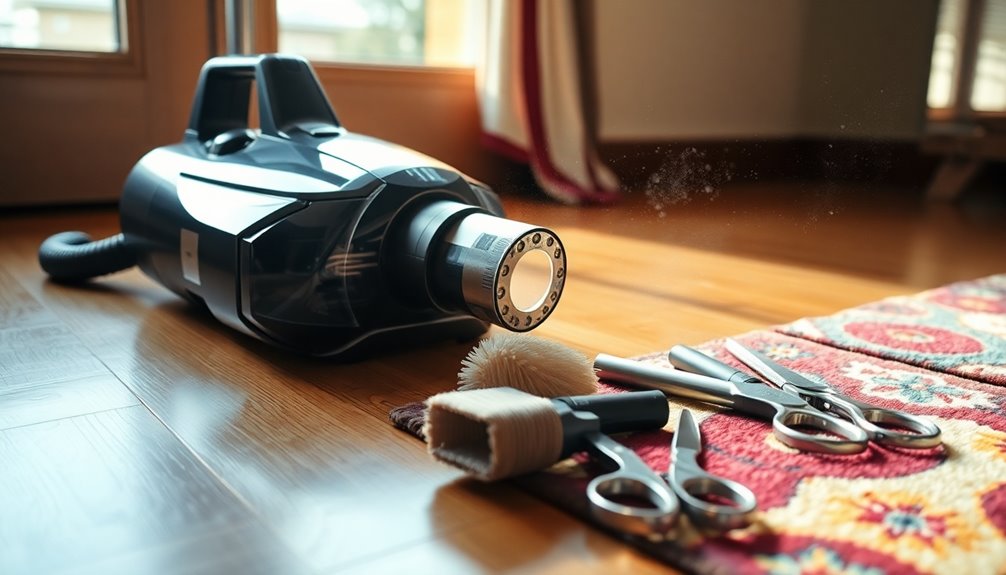
When it comes to deep-cleaning your vacuum, using compressed air can help you clear out hidden debris from tight spaces. Don't forget to replace worn-out parts like filters and brushes regularly to keep your vacuum running at its best. Familiarizing yourself with your vacuum's assembly will also make the cleaning process smoother and more efficient. Additionally, maintaining regular cleaning of your vacuum can prevent buildup and enhance its longevity. Regular maintenance can also prolong the lifespan of your vacuum, ensuring it operates effectively for years to come. Incorporating efficient tools into your vacuum cleaning routine can further improve its performance and cleanliness.
Compressed Air Usage
Many homeowners overlook the importance of using compressed air as a powerful tool for maintaining vacuum cleaners.
Utilizing compressed air can dramatically enhance your vacuum's performance by clearing hidden debris from tight spaces, like hoses and crevices. This guarantees peak airflow and suction power, providing a better cleaning experience.
Here are four key tips for using compressed air effectively:
- Choose the Right Canister: Opt for a canister of compressed air with a nozzle that fits into tight spaces.
- Aim Carefully: Always point the nozzle away from yourself and avoid delicate components to prevent damage.
- Wear Protective Gear: Use protective eyewear to shield yourself from flying debris while cleaning.
- Regular Maintenance: Make compressed air a regular part of your deep-cleaning routine to maintain peak airflow and suction power.
Replace Worn-Out Parts
Over time, vacuum cleaners can lose their effectiveness due to worn-out parts, making it vital to replace them regularly.
Start by inspecting the belts, which should be changed every 3-6 months based on your usage. Worn or stretched belts can hinder your vacuum's suction power, leading to poor performance.
Next, pay attention to the filters. If you have a HEPA filter, replace it every 6-12 months, while washable filters need cleaning every 8 weeks.
Clean filters not only enhance your vacuum's efficiency but also improve indoor air quality.
Don't overlook the roller brush. If the bristles are worn down or if debris has caused clogging, it's time to replace it.
A new roller brush can greatly improve your carpet cleaning efficiency and make sure you're picking up dirt effectively.
Vacuum Assembly Familiarity
Understanding your vacuum cleaner's assembly is essential for effective deep cleaning. When you're familiar with the components, you can quickly access parts that require maintenance, making sure your vacuum cleaner meets its needs for peak performance.
This knowledge helps you maintain suction power and troubleshoot common issues, like clogs, during your regular vacuum sessions.
Here are four key components you should know:
- Filters: Regularly check and clean or replace filters according to your vacuum's manual for specific guidelines.
- Brush Rolls: Inspect for hair or debris that can hinder performance; cleaning these can greatly improve efficiency.
- Hoses: Look for blockages and clear them out to prevent suction loss.
- Belt: Verify the belt is in good condition; a worn belt can affect the brush roll's movement.
Proper Bag Attachment
Securing the vacuum bag properly is vital for ideal performance and efficiency. When you attach the vacuum bag, make sure it's firmly in place, checking that all hooks, clips, or holders are secure.
An improperly attached vacuum bag can lead to dust and debris escaping into the vacuum instead of being collected, making it difficult for you to clean out dirt effectively. This not only hampers your cleaning efforts but can also cause potential damage to your vacuum's internal components.
To maintain suction and proper airflow, always verify the bag is fitted correctly. If you're using a bagless model, keep an eye on the max fill line. When the bag is about two-thirds full, consider replacing it to uphold peak suction power and prevent dirt from lingering on your floors and in the air.
Regularly monitoring your vacuum bag's status is vital for maintaining its efficiency and performance. By taking a few moments to check the bag attachment, you help guarantee that your vacuum runs smoothly and effectively, making your cleaning tasks much easier.
Regular Bag Replacement
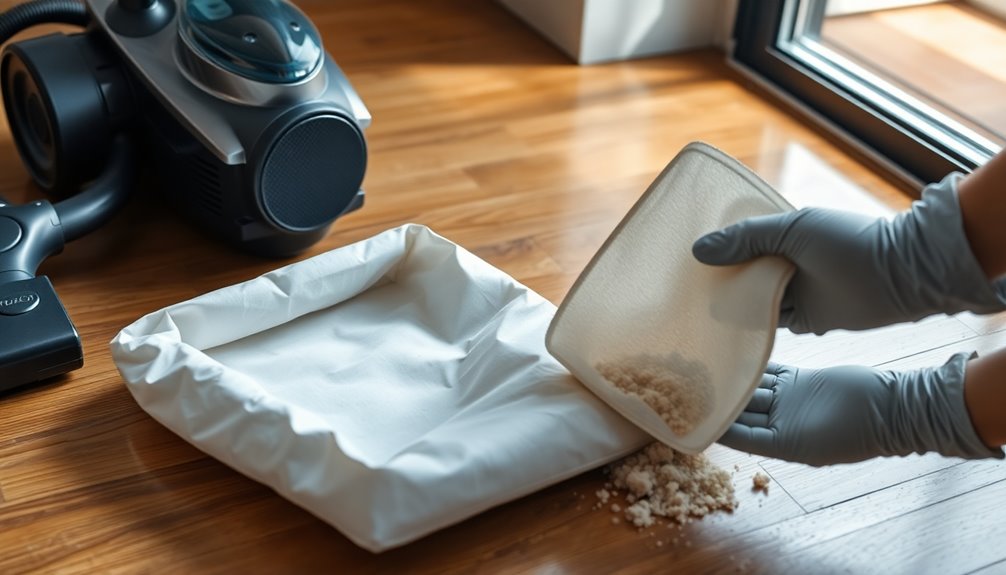
Regularly replacing the vacuum bag is vital for maintaining your vacuum's performance. When the bag is approximately two-thirds full, it's time for a change. This practice guarantees peak suction and prevents dirt from escaping back into the air, which can compromise indoor air quality.
Here are four key reasons to prioritize regular bag replacement:
- Efficiency: Full bags reduce airflow, making your vacuum work harder than necessary. This strain can decrease its performance and longevity.
- Dirt Removal: A clean bag allows for better dirt removal, guaranteeing that your home stays cleaner for longer.
- Performance Monitoring: If your vacuum doesn't have a full indicator, watch for drops in suction. This change can signal that it's time to replace the bag.
- Alternative Options: Consider switching to water-based vacuum systems, like Sirena, to eliminate the need for bag replacements and reduce dust exposure.
Filter Cleaning and Maintenance
Keeping your vacuum cleaner's filters clean is essential for peak performance. Regular maintenance guarantees that the filter in your vacuum operates effectively, allowing for maximum airflow and suction.
For washable filters, make it a habit to clean them every 8 weeks. Simply rinse them under warm water and let them air dry completely before reinstalling. This helps maintain efficient airflow and performance.
If your vacuum uses disposable filters, you should replace them every 4-6 months, or sooner if you notice a drop in suction power. This regular replacement helps trap dust and allergens effectively.
HEPA filters, known for their superior filtration capabilities, typically need replacing every 6-12 months. Always consult your vacuum's manual for specific cleaning and replacement instructions, as different models may have unique requirements.
Neglecting filter maintenance can lead to decreased efficiency and might shorten your vacuum's lifespan due to added strain on the motor.
Brush Maintenance
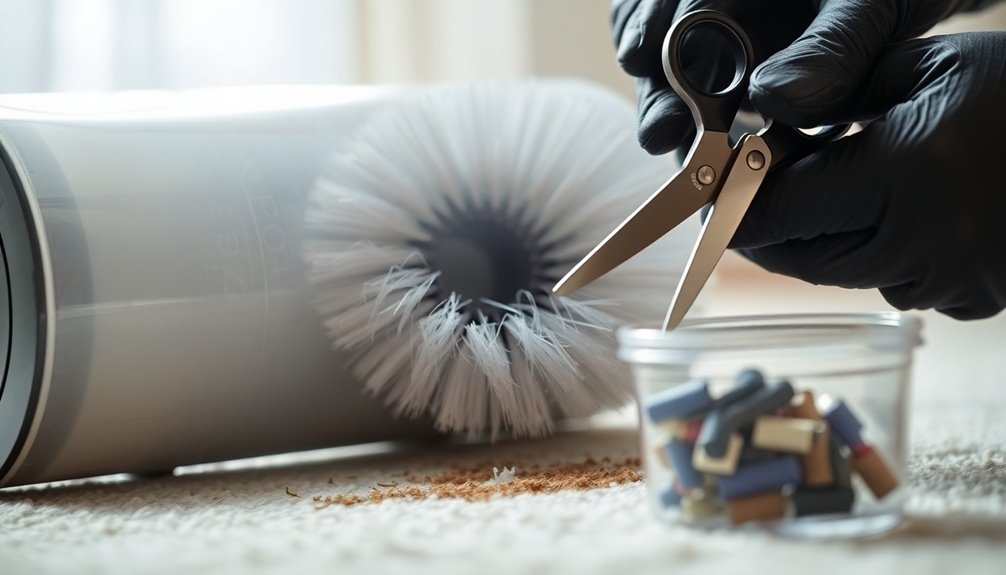
The brush roll is a crucial component of your vacuum cleaner, directly affecting its cleaning power. Regular maintenance is important to guarantee peak performance, so make it a habit to inspect the brush roll for hair, strings, and debris that can impede its movement.
Here's how to keep your brush in top shape:
- Detach the Brush Roll: Remove it from the vacuum cleaner carefully.
- Cut Away Tangles: Use scissors or a utility knife to remove any hair or strings wrapped around the brush.
- Wipe Down the Brush: After cutting away tangles, wipe the brush roll to eliminate remaining debris.
- Verify It's Dry: Before reattaching, make sure the brush roll is completely dry to prevent moisture-related issues.
Cleaning the brush roll every 1-2 months is recommended, as accumulated debris can stretch and wear out the belt faster.
A well-maintained brush roll enhances your vacuum's ability to agitate carpet fibers, leading to improved dirt and allergen removal.
Vacuum Performance Tips
To get the most out of your vacuum cleaner, paying attention to its performance is vital. Start by regularly cleaning the vacuum filters every 1-3 months. This helps guarantee ideal airflow and prevents reduced suction power from debris buildup.
Additionally, replace or clean the vacuum bag when it's about 70-80% full. This will maintain effective suction and prevent unnecessary strain on the motor.
Next, it's important to inspect and clean the brush roll every 1-2 months. Hair and debris can hinder its movement, greatly reducing cleaning effectiveness.
Properly adjusting the nozzle height according to your flooring type is also essential. This maximizes efficiency and prevents damage to both carpets and hard surfaces.
Finally, keep an eye on your vacuum performance. Look for signs of clogs or unusual smells, as these can indicate underlying issues.
Addressing any problems promptly will help avoid overheating and potential motor burnout. By following these tips, you'll guarantee your vacuum cleaner operates at its best, providing you with a cleaner home and prolonging the life of your appliance.
Troubleshooting Common Issues
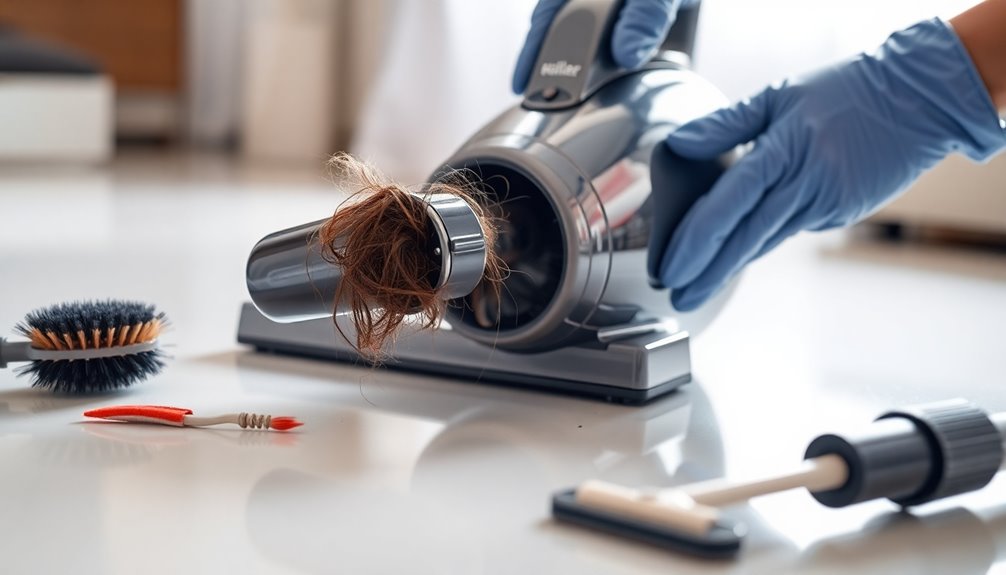
Even with proper maintenance, vacuum cleaners can still encounter issues that affect their performance. If you notice a drop in suction power, it's time to troubleshoot. Here are some common issues to check:
- Clogs: Inspect the hose, filters, and brush roll for any blockages that might hinder airflow.
- Unusual Smells: If you smell something strange or see smoke, a worn-out belt or overheating motor may be the culprit. Immediate inspection is essential.
- Strange Noises: Listen for odd sounds. These can indicate a jammed brush roll or damaged components, which might require disassembly for thorough cleaning.
- Poor Dirt Pickup: If your vacuum isn't picking up dirt effectively, check that the bag or dust container isn't full. Also, make sure to clean or replace the filters to maintain peak performance.
For persistent issues, refer to your vacuum's manual for specific troubleshooting tips tailored to your model.
Extending Your Vacuum's Life
Maintaining your vacuum cleaner is vital for extending its life and guaranteeing it operates at peak efficiency. To achieve this, vacuum cleaner maintenance should be a priority.
Start by regularly cleaning or replacing filters every 1-3 months. This keeps airflow ideal and prevents decreased efficiency. When your dust canister is about two-thirds full, empty it to avoid clogs and maintain consistent suction power.
Another important step is to inspect and clean the brush roll every 1-2 months. Hair and debris can tangle and hinder performance, so don't overlook this task.
Additionally, change the vacuum belt annually to make sure that the roller brush operates effectively, contributing to the overall life of your vacuum.
Lastly, schedule routine maintenance check-ups to identify any potential issues early. This proactive approach reduces the likelihood of costly repairs or replacements down the line.
Remember, extending the life of your vacuum requires consistent effort. By following these tips, you'll not only enhance its performance but also save money in the long run.
Keep these vital maintenance steps in mind, and you'll be well on your way to enjoying a longer-lasting vacuum cleaner.
Best Vacuum Options Available
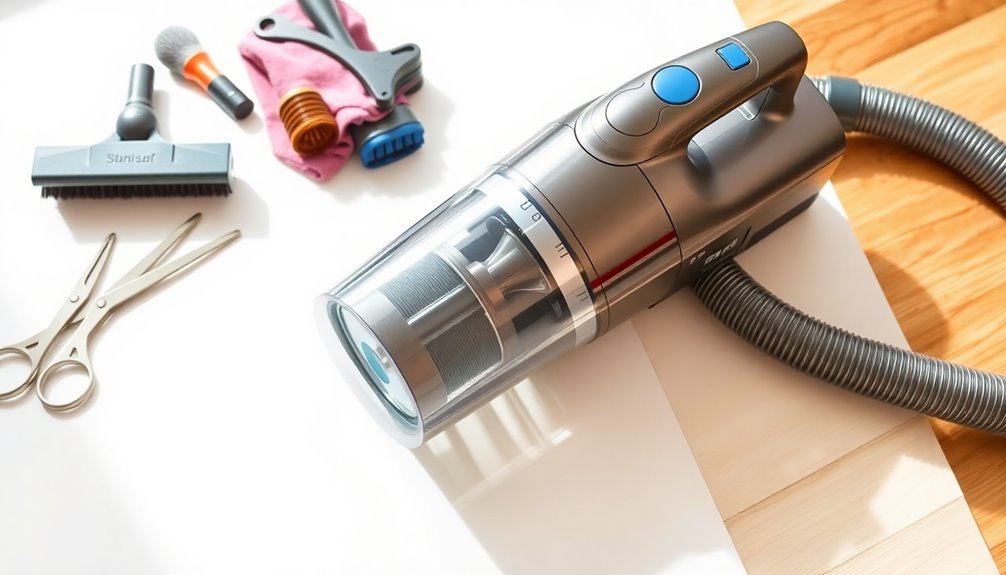
Exploring the best vacuum options available can make a significant difference in your cleaning routine. With so many choices out there, here are some of the top models you should consider:
- Dyson V11: Known for its powerful suction and adaptability, this vacuum model excels on various surfaces.
- Shark Navigator: This versatile vacuum offers strong performance and is highly rated for its ease of use.
- Miele Vacuums: Ideal for allergy sufferers, these vacuums feature HEPA filters that capture 99.97% of particles, guaranteeing a cleaner environment.
- Hoover WindTunnel Series: This bagless vacuum employs multi-cyclonic technology, delivering robust suction and is budget-friendly.
If you're looking for something unique, the Bissell CrossWave is a hybrid vacuum that vacuums and washes floors simultaneously, making it efficient for multi-surface cleaning.
By choosing one of these best vacuum options, you can maintain proper cleanliness without hassle.
Remember to regularly clean and maintain your vacuum to guarantee peak performance and longevity.
Conclusion
By giving your vacuum a little TLC, you're not just keeping it clean—you're ensuring it runs like a well-oiled machine. Just as a gardener tends to their plants, nurturing your vacuum will yield a bountiful harvest of dust-free floors and fresh air. Remember, a small investment in maintenance now can save you from the storm of costly repairs later. So, roll up your sleeves and embrace the art of vacuum care; your home will thank you for it!